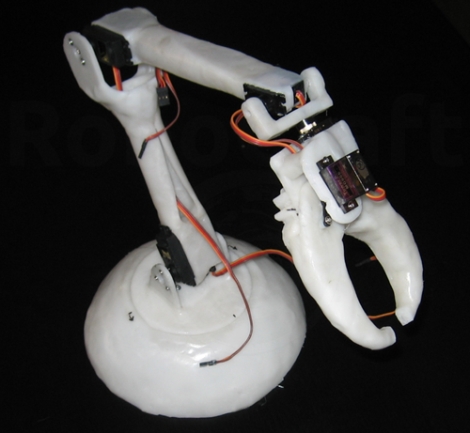
[Alexey] wrote in to share a mechanical claw (Google Translation) he has been hard at work on for quite some time. While a lot of people will turn to some sort of 3D plastic printer such as the MakerBot if they need plastic parts built, [Alexey] didn’t have access to one. Instead, he carefully crafted the entire mechanism from polycaprolactone, or as it’s more commonly known, Shapelock.
Using a wide range of tools from hair dryers and knives to lighting fixtures, he manually sculpted the claw and its control arm out of plastic, piece by piece. We are particularly impressed by the gearing he was able to cut from the plastic, which can be finicky at times.
As you can see in the video below, The claw mimics each movement he makes with the control arm via a handful of Arduino-driven servos. Everything seems to work quite well, and despite the rough translation by Google, we think this is a great project. If you are looking to do something similar yourself, he has plenty of pictures on his site, which should give you a pretty good idea as to how things were put together.
[youtube=http://www.youtube.com/watch?v=P3PQP8FQU4A&w=470]
[youtube=http://www.youtube.com/watch?v=1VrfoP-DH0g&w=470]















very neat
It’s a skutter.
Ha! I thought the same thing! Oh Bob…
клево получилось!
I’m really digging the control mechanism. That should be highlighted as much as the fact that he cobbled it together in an interesting way. Good find.
Wow! Having worked with Shapelock in the past, I admire the quality of the production and the use of different materials to shape the arm. Respect sir.
Seems a fair amount of hysteresis introduced from the play in either the control or the shape lock.
It should be easy enough to iron out with a dead-zone(epsilon) checking function.
i want one! wait no, i want this merged with the hexapod posted earlier:
http://hackaday.com/2011/08/18/morphing-hexapod-has-us-drooling/
then i want it with AI
then i’ll be happy
maybe.
worth a shot :)
THIS ROBOT IS MADE FROM CHEESE!!!!
Oops. Caprolactone is prepared industrially by Baeyer-Villiger oxidation of cyclohexanone with peracetic acid. So…. not actually made from milk products.
Wow, that’s really cool.
its not my job – its Zoltbrg (Alexey) work :)
I agree with Brad. That control arm is just as cool as the robot arm.
Did they really put condoms over the gripper for better traction!? I’ll never trust the advertisements again. ;D
Oddly, the more organic feel given by the hand scuplted Shapelock makes it actually look quite scary. Almost insect like.
Nice hack!
I wonder if the same sort of idea would work to make a full function gripping prosthetic hand with off the shelf parts?
When something basic costs £30K then you can see the advantage of a homebrew version.
Combine with dry electrode EEG based control and this could help a lot of people use a PC, etc.
Come to think of it, did anyone other than me come up with the idea of using eye iris diameter/ focus muscles as a control for people who have virtually no remaining muscle movements i.e. ALS patients? would make sense, as it is relatively easy to read the eye’s focal length using a simple CMOS camera and low power IR LED.
Bothersaidpooh: can you point me to some info on focal length determination with CMOS and ir led please?
TIA.
I’ve thought about the same thing. Prosthetics seem ludicrously expensive for what is in essence some bits of plastic and silicone, 3 emg electrodes and amplifier, a microcontroller, a servo and some decent rechargeable batteries.
Even more astounding is the fact that I have yet to see any off-the-shelf prosthetic device with any form of feedback! Sensory substitution anyone? The cost of adding a couple of flex and force sensors coupled to button vibrators in contact with the skin seems negligible compared to the vast improvement in usability and the astonishingly high price of the device as is.
Looks like they have “Free” Shapelock with $4.95 shipping.
http://shapelock.com/page3.html
That’s a 1.23oz trial. Amazon sells Instamorph for $9.95 for 8oz – with free shipping through Amazon Prime (free trials can be found – google “Amazon Mom”)
I’ve never heard of the stuff before – might have to give it a try! I have a share of things that I wish I had a RepRap to print a part for – maybe this stuff could work?
How many ounces of Shapelock would make the posted project?
nope :)
Wow am going to have to do a project like this i can think of lots of way i coulduse one
what type of servo did you use in this project?